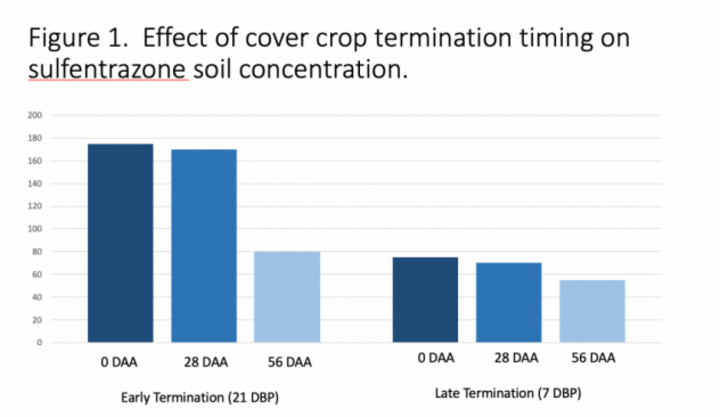The following article by Bob Hartzler and Meaghan Anderson, extension specialists for Iowa State University Extension and Outreach, is reprinted from the ISU Integrated Crop Management News with permission.
A common question when incorporating cover crops into a production system is, will the cover crop interfere with the performance of residual herbicides included with the burndown treatment? This article will discuss the fate of residual herbicides applied to crop residue and living cover crops, and how this may influence herbicide effectiveness.
Crop residue and residual herbicides
Considerable research has evaluated the fate of herbicide intercepted by crop residue present on the soil surface in conservation tillage systems. Agricultural Engineers at Iowa State (Baker and Shiers, 1989) determined 70-90% of preemergence herbicides was washed off corn residue with 2.7 inches of rain, with the majority coming off in the first 0.6 inch of rain. There were small differences in washoff of different herbicides. This research indicates that herbicide interception by dead plant material isn’t a major concern.
Cover crops and residual herbicides

While herbicide interception by dead plant material isn’t a major concern, interception by living plants could be a concern. Weed scientists at the University of Missouri (Whalen et al. 2020) studied how cover crop termination timing affected the quantity of sulfentrazone reaching the soil. Several cover crop species were established in the fall, and a combination of 2,4-D and glyphosate was applied either 21 or 7 days before soybean planting to terminate the cover crops. Authority Maxx (sulfentrazone plus chlorimuron) was included in the burndown mixture to provide residual weed control. The concentration of sulfentrazone in the upper five inches of the soil profile was measured immediately after application and throughout the growing season to determine the impact of interception by cover crops on the availability of residual herbicides.
Averaged over cover crop species, there was approximately a 50% increase in biomass between the early and late termination dates. This increase in biomass between termination dates reduced the amount of sulfentrazone directly reaching the soil by more than 50% (Figure 1). Sulfentrazone soil concentrations declined by about 5% in both termination dates during the first 28 days following application, suggesting sulfentrazone intercepted by the large cover crops (late termination date) was not released into the soil as the cover crop degraded. The reduced availability of sulfentrazone was reflected in waterhemp control, with a 20% reduction in control between the early and late termination dates.
Managing residual herbicides with cover crops
So how do we best integrate residual herbicides with cover crops? If cover crops are terminated early (less than 12-18 inches in height), residual herbicides should be included with the burndown application since there isn’t enough cover crop biomass to significantly suppress weeds. While a portion of the residual herbicide will be intercepted by cover crops with early termination dates, small cover crop plants break down quickly and it is likely some of the intercepted herbicide will reach the soil.
As termination is delayed and more cover crop biomass accumulates, the answer isn’t quite as simple. In fields with dense, uniform cover crop biomass, omitting the residual herbicide from the termination application and including it with the postemergence application may be advantageous. In this scenario the cover crop biomass can provide effective early-season weed control, replacing the residual herbicide applied at planting. Unfortunately, many fields have uneven stands of cover crop where there are areas with insufficient cover crop biomass to control weeds. Due to the risks of escaped weeds and increased selection pressure for herbicide resistance associated with total postemergence programs, including a residual product in fields lacking uniform stands of cover crops will be necessary.
Baker, J.L. and L.E. Shiers. 1989. Effects of herbicide formulation and application method on washoff from corn residue. Trans. ASAE. 32:830-833.
Whalen, D. M., L.S. Shergill, L.P. Kinne, M.D. Bish and K.W. Bradley. 2020. Integration of residual herbicides with cover crop termination in soybean. Weed Technol. 34:11-18.
Bob Hartzler
Extension Weed Specialist, Iowa State University, Department of Agronomy
Meaghan Anderson
Extension Field Specialist, Iowa State University
